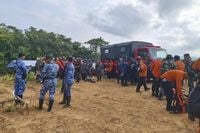On the morning of September 1, 2025, the dense forests of Borneo became the backdrop for a dramatic search-and-rescue operation after a helicopter carrying eight people vanished only minutes after takeoff. The Airbus BK117 D-3, operated by Eastindo Air, departed from Kotabaru district in Indonesia’s South Kalimantan province at precisely 8:46 a.m., bound for Palangkaraya city in Central Kalimantan province. Its scheduled arrival was 10:15 a.m., a routine journey that suddenly turned into a race against time and the elements.
According to the Associated Press, the helicopter’s last contact with air traffic control was at 8:54 a.m.—just eight minutes after departure. The loss of communication occurred as the aircraft flew over the Mantewe forest area in Tanahbumbu district, a remote region characterized by low hills and a thick, almost impenetrable tropical canopy. The Banjarmasin Search and Rescue Agency received the first report about the missing helicopter at 12:02 p.m., triggering immediate concern and mobilization of resources.
Aris Maulana, spokesperson for Banjarmasin Basarnas, told Bernama, “So far there is no information on survivors or fatalities.” The helicopter carried a total of eight people: one pilot, one engineer, and six passengers. Notably, three of those on board were foreign nationals—an American, a Brazilian, and an Indian—adding an international dimension to the unfolding crisis, as reported by the Associated Press.
The last known position of the helicopter was approximately four kilometers from Mandin Damar Waterfall in Mantewe district, according to Bernama. This area, with its rugged terrain and dense foliage, poses significant challenges for search teams. The helicopter’s disappearance from radar in such a remote location immediately raised fears about the fate of those onboard, as well as the complexity of mounting an effective search and rescue effort.
By the following day, September 2, the scale of the rescue operation had grown dramatically. The Associated Press reported that a total of 140 personnel—drawn from the police, military, local agencies, and even local residents—were deployed by land and air. The teams focused their efforts on a 27-square-kilometer (roughly 10 square mile) stretch of forest in the Mantewe area. Two helicopters were also brought in to sweep the region from above, alternating their flights to maximize coverage and efficiency.
I Putu Sudayana, head of the Banjarmasin Search and Rescue Agency, expressed the hopes of the entire team and the anxious families waiting for news. “Hopefully, with everyone’s prayers, today’s operation will be successful and we will be able to find the location of the incident,” Sudayana said, as quoted by the Associated Press. Earlier, he had remarked, “Hopefully today we can find the location and we hope to find them safe and sound.” The sense of urgency was palpable, with every minute that passed increasing the challenge for rescuers and the worry for loved ones.
The circumstances of the disappearance were as sudden as they were mysterious. The helicopter, an Airbus MBB BK117-D3, was a modern model operated by Eastindo Air, a company with experience in the region. The flight plan was straightforward, and weather conditions at the time of departure were reportedly normal. The abrupt loss of contact just eight minutes after takeoff, before the aircraft disappeared from radar, left authorities with few immediate clues. The fact that the last known position was in a particularly remote and rugged part of Borneo only compounded the difficulties.
The search operation quickly became a test of coordination and endurance. Teams on the ground had to navigate dense jungle, steep hills, and unpredictable weather, while air crews contended with limited visibility and the ever-present risk of sudden storms. The use of helicopters typically deployed for firefighting underscored the seriousness of the mission and the need for specialized equipment to reach such an inaccessible area.
As the hours and then days passed, the lack of information about survivors or fatalities weighed heavily on everyone involved. Authorities made it clear that, as of September 2, no wreckage had been found and there was still no word on the fate of those aboard. The international composition of the passenger list also meant that embassies and families from several countries were anxiously awaiting updates, further heightening the sense of urgency and the need for clear communication.
The disappearance also prompted broader questions about aviation safety in Indonesia’s vast and often challenging landscape. The country, with its thousands of islands and extensive rainforests, relies heavily on air transport for both passengers and cargo. While Indonesia has made significant improvements in aviation safety over the past decade, incidents in remote or mountainous regions remain a persistent risk, often due to unpredictable weather, difficult terrain, and the sheer distances involved.
In the days following the incident, the search continued with renewed determination. Local residents joined the official teams, bringing their knowledge of the terrain and willingness to help. The operation became a community effort, reflecting both the gravity of the situation and the resilience of those living in Borneo’s remote districts. The deployment of two helicopters, alternating their sweeps of the search area, allowed for near-constant aerial surveillance, while ground teams pushed deeper into the forest, sometimes on foot and sometimes using off-road vehicles.
Despite the scale of the operation, the dense jungle and rugged landscape made progress slow and painstaking. Searchers had to contend with thick undergrowth, muddy trails, and the ever-present risk of injury or getting lost themselves. Yet, as I Putu Sudayana emphasized, the goal remained clear: to locate the missing helicopter and, if possible, bring the passengers and crew home safely.
The story of the missing helicopter on Borneo is a stark reminder of both the challenges and the importance of rapid, coordinated response in aviation emergencies. It also highlights the courage and dedication of search and rescue teams, who risk their own safety in the hope of saving others. As families, friends, and colleagues around the world await news, the search continues—driven by hope, determination, and the belief that even in the most difficult circumstances, every effort must be made.






